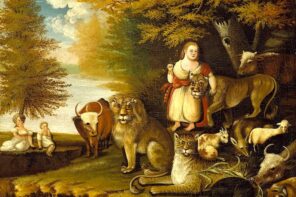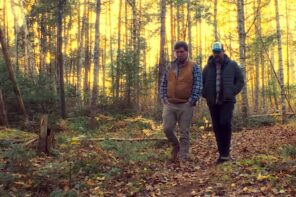In the dry red soil of Chimayo, New Mexico, there is a hole in the ground that some call holy. They intend no pun, no play on words. The hole is a serious matter; the locals who tend to it would no more joke about their humble opening in the earth than they would a hole in the head, or the heart.
An arm’s length in diameter and just deep enough that the temperature seems to drop when you lean in for a closer look, the hole has been here for centuries. The dirt in this valley has been regarded as sacred since before the birth of the republic of which it is now a part; it has been revered as the physical nature of the spirit world since before the Spanish missionaries arrived with their own notions of embodied divinity; it was holy even before the first Europeans looked on the people of an unmapped continent and declared that they must know nothing of God.
Though it has a long and eclectic spiritual history, the hole sits today in the back corner of a Roman Catholic Church, El Santuario de Chimayo, which is among the most visited religious pilgrimage sites in America. Hundreds of thousands of true believers and curious souls visit every year to line up in a small side chapel strewn with empty plastic bags and pictures of loved ones lost. They crowd into a closet-sized space around the hole, bend at the knees, dip their hands into the cool of the gap below, and pull up big handfuls of dirt. Some of it ends up in Ziploc baggies, some in Tupperware tubs to be taken home on airplanes to every corner of this improbable nation. Most of it ends up in the mouths of the faithful. Visitors to Chimayo believe eating the dirt brings miracles; as evidence they point to the crutches hanging from the walls.
Some would call this practice folk religion – not the real or legitimate orthopraxy of a Christian church, but an indigenous corruption of the sanctioned sacrament of communion. Others might suggest it is in fact something more interesting: a distinctly American form of religious syncretism, a blending of faith traditions so complete that it is difficult to separate one from the other. Taken for granted by each of these explanations is a more obvious physical truth. The church at Chimayo was built over a hole in the ground that has history both connected to and independent of the structure around it.
To extend the metaphor, the practices seen at Chimayo beg the question: In thinking about religion in America—both in terms of how it might be mapped today, and in light of a history far more diverse than often remembered—have we too often focused only on the church standing above the hole, and not on the hole itself? Do we consider the façade at the expense of the people who pass through it to make the soil within a part of their blood, their bones? The United States is a land everywhere shaped and informed by the kind of internal religious diversity Chimayo proudly displays – some of it obvious, some of it hidden – and yet the categories we use to discuss American religion mostly fail to convey this. The hole is a reminder that we have learned history from the middle rather than the margins, that we look for the center as the norm and dismiss the edges as exceptions, though it is on the latter that so much of our culture has been formed.
This is of course a broad interpretation, but it’s built on a historical foundation as specific as the dirt itself.
According to an account published in 1915, the tiny Catholic shrine in the foothills of the Sangre de Cristo mountains had been built early in the previous century “on the spot where for long years wonderful cures had been performed by the strange virtue of the soil.” From its earliest days, it had been a location which “every day throughout the year” attracted “men, women, and children from all directions… all inspired with full faith in the supernatural remedial power that is here manifested.”
It was not uncommon to see among the crowds “in carriages, in wagons, on horses, on burros, or on foot,” entire families in the company of “some little one deformed from birth or injured by accident, whose case is beyond the curative power of the most skilful physician.” When they arrived, these families would approach a small hole cut in the church floor – el pocito, the “little well,” as it is called — and scoop out “a small amount of the sacred earth and make a kind of tea or drink of it… Those who come long distances usually take back with them a small quantity of the earth as a safeguard for the future.” In cases of illness so severe that the infirm could not be brought to Chimayo, Chimayo could be brought home a handful at a time.
Those who made use of the powers of el pocito did not concern themselves with how the miracles began (“How and when the healing virtues of the sacred earth of this favored spot were first manifested, not even tradition tells us…”) but it was generally accepted that the local Tewa people had visited this site for much the same purpose long before the first Spanish missionaries arrived. The church was built here, in other words, because the ground itself was already regarded as holy.
Founded by Christians on land sacred to people who had lived there for millennia, El Santuario de Chimayo might be seen as a reply to the long-ago challenge put before Native Americans by the Spanish Requerimiento, which told them in no uncertain terms that they must abandon their beliefs and cultures or die. The answer given, centuries in the making, was that if they must be changed by the faith brought across the ocean, then that faith itself would be transformed as well.
From the intersection of these two conflicting traditions, which first squared off during a meeting of European and American gods more than five hundred years ago, there arose a religious site of interest to pilgrims who might consider themselves Roman Catholic, Native American, both, or neither. As the shrine’s own welcoming materials state, “Visitors to El Santuario come from all over the world and represent many diverse religious and cultural beliefs. Many are pilgrims who walk long distances, sometimes barefoot, sometimes carrying large wooden crosses. Some visitors are Jews, Hindus, Muslims or Buddhists who come initially out of simple curiosity. Some are blessed with the belief that they are at a place of God that transcends those things which tend to separate us.”
As the shrine’s description of the visitors to its divot of sacred soil suggests the story told by this “little well” in New Mexico belongs equally to all Americans. This goes beyond the physical; it is not just a matter of the chunk of earth that we call the United States. The hole at the back of the church is a product of the same process of conflict, negotiation, and compromise that can be seen throughout American history. Though the epic of belief and unbelief in America seems from the start to be one of weaker faiths and unpopular ideas vanquished by those strong enough to impose creeds and consequences as they see fit, the more enduring theme in this saga is resistance.
According to legend, one of the miraculous aspects of el pocito is that no matter how many come to fill their mouths, plastic bags, or coffee cans, the hole will never be empty. The priests in charge of the shrine smile at this suggestion, and then point discreetly behind the church, where a huge pile of freshly delivered soil awaits blessing with holy water before it is transported by shovel, sweat, and wheelbarrow inside the church. Often the priests are too busy to fill the hole themselves, and so they have been known to provide a bucket to the willing and ask volunteers to lend a hand.
If the shrine is too crowded for these deputized hole-fillers to make their way to the front of the assembled faithful, the bucket will pass from hand to hand through a room decorated with cast off crutches and photographs of those in need of healing. When the hole is finally refilled, it is through the efforts of many, working in concert despite differences, for the benefit of those they may never know.
At a time when the gulf between Americans who proudly call themselves religious and those who emphatically do not never seemed so wide, it bears remembering: Beliefs are malleable, the borders between them are porous. Belief, in all its varieties, non-belief included, is far more collaborative than we usually suppose.
Filling a hole with dirt is a process few would call sacred, but at times it does seem to make the little well, like the vast nation of which it is both a symbol and a part, a miracle of the most unlikely kind.
This piece was adapted from One Nation Under Gods: A New American History (Little, Brown and Company, 2015).
Image of the holy dirt at El Santuario de Chimayo: Jenni Konrad via Flickr/Creative Commons





